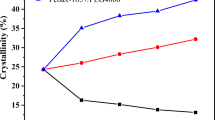Abstract
Polyethylene glycol (PEG) as a promoting material for CO2 separation performance of a composite membrane is introduced into the polytrifluoropropylmethylsiloxane (PTFPMS) network to form a blend selective layer coated on a porous polyetherimide (PEI) support membrane. The maximum blend ratio of PEG to PTFMS in mass is determined for PEG-400, PEG-600, and PEG-1000 at 0.5, 0.2 and 0.2 from the blend solution status observed by an optical microscope. The miscibility of PEG and PTFPMS is verified from one peak of the blend film in DSC characterization. Furthermore, the interaction between PEG and PTFPMS is van der Waals force from the decreasing strength of ether group in ATR-FTIR analysis. The stability of the PEG/PTFPMS blend composite membrane is investigated with pure N2, O2, and CO2 permeation experiments under the transmembrane pressure difference up to 1.0 MPa. The N2 permeation rate of the PEG400/PTFPMS blend composite membrane with a blend ratio of 0.2 is 2.11 GPU, while the O2/N2 and CO2/N2 selectivities are improved to 2.67 and 26.67, respectively, which are higher than those of pure PTFPMS composite membrane that is 2.2 and 13.79, respectively.












Similar content being viewed by others
References
Deng S et al (2011) Deformation and fracture of polystyrene/polypropylene blends: a simulation study. Polymer 52(24):5681–5694
Rodkate N et al (2010) Semi-interpenetrating polymer network hydrogels between polydimethylsiloxane/polyethylene glycol and chitosan. Carbohydr Polym 81(3):617–625
Li J et al (1998) Effect of polyethyleneglycol (PEG) on gas permeabilities and permselectivities in its cellulose acetate (CA) blend membranes. J Membr Sci 138(2):143–152
Xia J, Liu S, Chung T-S (2011) Effect of end groups and grafting on the CO2 separation performance of poly(ethylene glycol) based membranes. Macromolecules 44(19):7727–7736
chemicalland21 (2013) Polyethylene Glycol. Available from. http://chemicalland21.com/industrialchem/organic/POLYETHYLENE%20GLYCOL.htm
Zhao H-Y et al (2008) Poly(ethylene oxide) induced cross-linking modification of Matrimid membranes for selective separation of CO2. J Membr Sci 320(1–2):179–184
Yi C et al (2006) Facilitated transport of CO2 through polyvinylamine/polyethlene glycol blend membranes. Desalination 193(1–3):90–96
Ben Hamouda S et al (2009) Poly(vinylalcohol)/poly(ethyleneglycol)/poly(ethyleneimine) blend membranes - structure and CO2 facilitated transport. C R Chim 13(3):372–379
Car A et al (2008) PEG modified poly(amide-b-ethylene oxide) membranes for CO2 separation. J Membr Sci 307(1):88–95
Reijerkerk SR et al (2010) Poly(ethylene glycol) and poly(dimethyl siloxane): combining their advantages into efficient CO2 gas separation membranes. J Membr Sci 352(1–2):126–135
Owen MJ (1988) Surface tension of polytrifluoropropylmethylsiloxane. J Appl Polym Sci 35(4):895–901
Kobayashi H, Nishiumi W (1993) Preparation and characterization of poly(methyl-3,3,3-trifluoropropylsiloxane-co-dimethylsiloxane). Makromol Chem 194(5):1403–1410
Su T et al (2006) Preparation and properties of waterborne polyurethaneurea consisting of fluorinated siloxane units. J Polym Sci A Polym Chem 44(10):3365–3373
Fried JR, Hu N (2003) The molecular basis of CO2 interaction with polymers containing fluorinated groups: computational chemistry of model compounds and molecular simulation of poly[bis(2,2,2-trifluoroethoxy)phosphazene]. Polymer 44(15):4363–4372
Zhang XK et al (2008) Pervaporation of organic liquids from binary aqueous mixtures using poly(trifluoropropylmethylsiloxane) and poly(dimethylsiloxane) dense membranes. J Inorg Organomet Polym Mater 18(2):246–252
Zhang L et al (2011) Studies on the coating layer in a PTFPMS/PEI composite membrane for gaseous separation. J Membr Sci 371(1–2):141–147
Zhang L et al (2010) Effect of formamide additive on the structure and gas permeation performance of polyethermide membrane. Sep Purif Technol 73(2):188–193
Zhao W et al (2010) Effect of water in ionic liquid on the separation performance of supported ionic liquid membrane for CO2/N2. J Membr Sci 350(1–2):279–285
Ahn J et al (2008) Polysulfone/silica nanoparticle mixed-matrix membranes for gas separation. J Membr Sci 314(1–2):123–133
Lin H, Freeman BD (2004) Gas solubility, diffusivity and permeability in poly(ethylene oxide). J Membr Sci 239(1):105–117
Stern SA, Shah VM, Hardy BJ (1987) Structure-permeability relationships in silicone polymers. J Polym Sci B Polym Phys 25(6):1263–1298
Charati SG, Stern SA (1998) Diffusion of gases in silicone polymers: molecular dynamics simulations. Macromolecules 31(16):5529–5535
Enterprises D. http://www.accudynetest.com/solubility_table.html
Cai L, Wang K, Wang S (2010) Poly(ethylene glycol)-grafted poly(propylene fumarate) networks and parabolic dependence of MC3T3 cell behavior on the network composition. Biomaterials 31(16):4457–4466
Lamia N et al (2009) Adsorption of propane, propylene and isobutane on a metal-organic framework: molecular simulation and experiment. Chem Eng Sci 64(14):3246–3259
Cecopieri-Goez ML, Palacios-Alquisira J, Dominguez JM (2007) On the limits of gas separation in CO2/CH4, N2/CH4 and CO2/N2 binary mixtures using polyimide membranes. J Membr Sci 293(1–2):53–65
Robeson LM (2008) The upper bound revisited. J Membr Sci 320(1–2):390–400
Acknowledgments
The authors thank the financial support of National Science Fund for Distinguished Young Scholars of China (21125628) and the National High Technology Research and Development Program of China (2012AA03A611).
Author information
Authors and Affiliations
Corresponding author
Rights and permissions
About this article
Cite this article
Nie, F., He, G., Zhao, W. et al. Improving CO2 separation performance of the polyethylene glycol (PEG)/polytrifluoropropylsiloxane (PTFPMS) blend composite membrane. J Polym Res 21, 319 (2014). https://doi.org/10.1007/s10965-013-0319-x
Received:
Accepted:
Published:
DOI: https://doi.org/10.1007/s10965-013-0319-x



